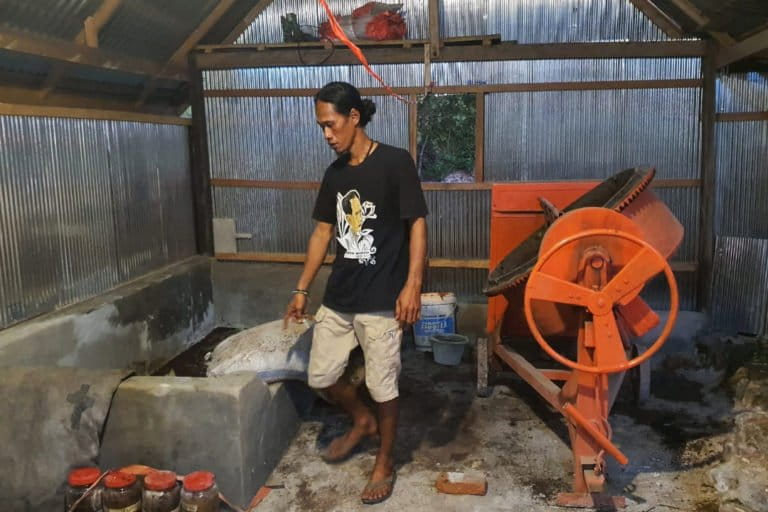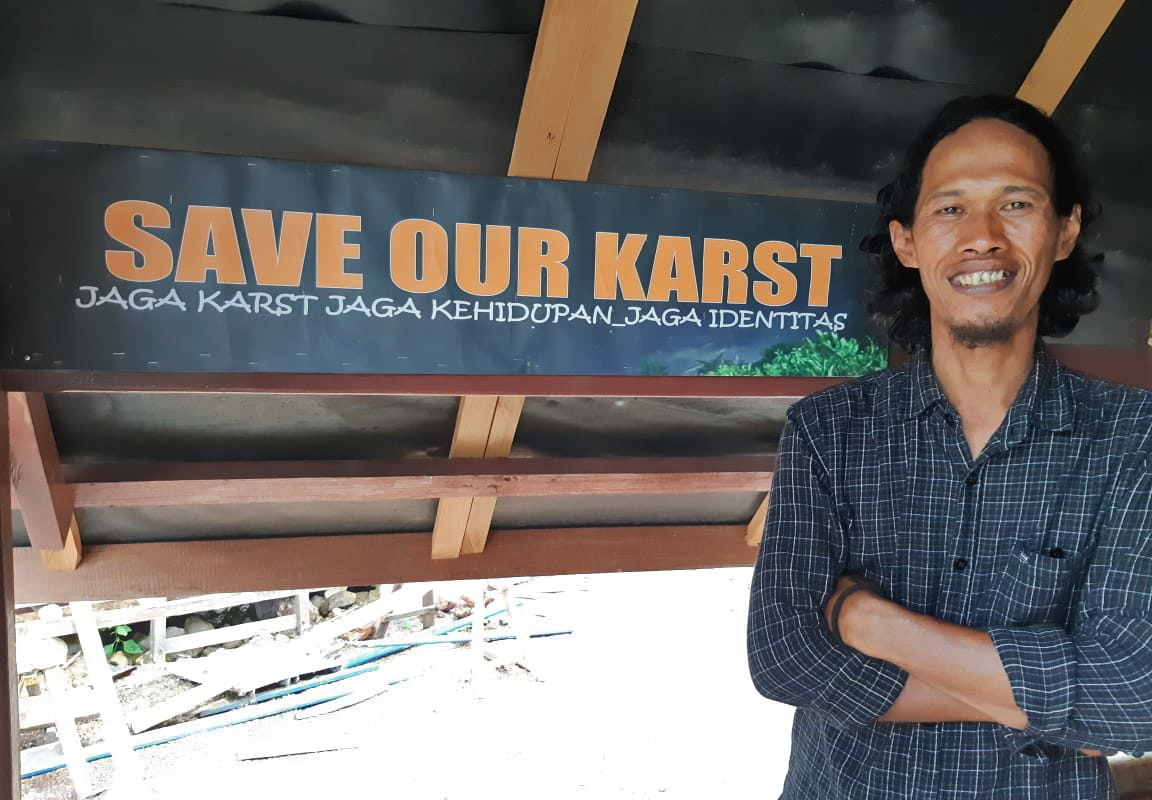
- For more than a decade, environmental activist Iwan Dento has opposed the mining of the limestone karst formations in his homeland of Maros, Indonesia.
- Until 2013, the karst mountain area of Rammang-rammang was mined for marble and limestone, but local resistance led to protective regulations and the establishment of an ecotourism area.
- For his dedication to defending the karst and establishing ecotourism, Iwan Dento has been nominated for several top honors for environmental preservation by both the government and the private sector, and is seen as the “hero” of Rammang-rammang.
MAROS, Indonesia — Forty-two kilometers, or about 26 miles, north of the bustling port city of Makassar in Indonesia’s South Sulawesi province, undulating karst formations dominate the landscape. Covering an area of about 43,000 hectares (106,300 acres), the mountains sprawl across two administrative districts, Maros and the Pangkajene Islands (Pangkep), forming the second-largest karst area in the world. Hidden in the limestone are hundreds of caves, many of which contain evidence of prehistoric civilization dating back more than 40,000 years. Several species endemic to Sulawesi, such as the crested black macaque (of “monkey selfie” fame), have also been found in the region.
In Salenrang village lies Rammang-rammang, a cluster of karst formations with an inspiring story: once mined for marble and limestone, the area is now protected and home to a popular ecotourism initiative. Resident and environmental activist Muhammad Ikhwan, known as Iwan Dento, who led the fight to stop the mining activities and establish ecotourism in their place, was recently recognized as a “hero” of Rammang-rammang in an annual awards ceremony for social impact held by Indonesia’s top national news TV station.
Together with other residents of Salenrang, for more than 10 years Iwan struggled to defend his homeland from the threat of extractive industries. Before it became a tourism village, inaugurated by Indonesia’s tourism minister in 2021, the area was being degraded by limestone and marble quarries. A cement mine was also located nearby.

“The biggest challenge was actually from residents themselves who didn’t really want the mining to be stopped because they were receiving its economic benefits,” Iwan said. “The company also tried to persuade me. If I wanted to, I could have accepted the lure of money, which was certainly not an insignificant amount.”
Indonesia is no stranger to grassroots movements rising to defend karst formations from extractive industries.
In 2005, a major cement company announced plans to build factories in the Kendeng mountains in Central Java, despite fears among residents that the factories would poison the groundwater basin on which their agriculture-based livelihoods depended. Local women led years of protests against the factories, and in 2016, those at the core of the movement captured the nation’s attention by setting their feet in cement in front of the Presidential Palace in Jakarta. That same year it was reported that almost 10% of Indonesia’s 155,000 square kilometers (nearly 60,000 square miles) of karst formations had been damaged by extractive industries and land conversion.
In 2017, activists called on the government to issue a new regulation aimed at better protecting Indonesia’s karsts.

The end of the mining era
The movement to stop the mining activities in Rammang-rammang began in 2009 and ended with the Maros district government revoking various mining permits in the area in 2013. After the end of the mining era, the challenge began for residents to prevent the mining companies from returning and to find an alternative livelihood.
Ecotourism was chosen as the area was already beginning to attract visitors, mostly researchers and small groups. Other areas in Indonesia threatened by extractive industries are also weighing up the same future: the Aru Islands in eastern Indonesia are considering ecotourism as a means to prevent agribusiness from damaging their delicate, small-island ecosystem.
Prioritizing conservation, education, and community empowerment, and employing around 200 residents, the Rammang-rammang ecotourism area was launched in 2015. Within the first year, it was visited by thousands of travelers. The same year, the Maros-Pangkep Geopark was established to protect the region’s archaeological, ecological and cultural value. It became a national geopark in 2017, and is currently being assessed for UNESCO Global Geopark status.
Iwan contributed to the management of the Rammang-rammang tourism venture, and also established several initiatives such as waste management, river conservation, organic farming, and developing local cuisine.

He said that while turning Rammang-rammang into a tourism center might not necessarily be the best choice for the area, it’s a much better option than mining.
“This is seen from the perspective of regional protection,” he said. “Looking at the current situation, we are quite happy that we can prove that we can manage this place well through tourism.”
The desire to safeguard the karst formations also motivated various local groups to strive for legal protection, which resulted in the regional government issuing a protective regulation in 2019. The regulation prohibits excessive exploitation, either by companies or the community itself, and should impact the sustainability of the tourism area, Iwan said.
“We hope that our current activities will be passed on to future generations,” he said. “We need state recognition, because this is an important issue.”
For his dedication to protecting the karst mountains and helping to establish ecotourism, Iwan was named one of seven “Kick Andy Heroes” by Jakarta-based Metro TV this year. In 2015, he was a finalist in the TV station’s documentary competition, the Eagle Awards, and in 2020 he was nominated for a Kalpataru award from the Ministry of Environment and Forestry.

A new era of tourism management
Indonesia’s tourism minister, Sandiaga Uno, inaugurated Salenrang as a “tourism village” in mid-2021, marking a new era of tourism in the area. Indonesia is home to around 1,200 tourism villages, which are developed with the aims of environmental conservation, cultural preservation, and economic regeneration, with a strong focus on prioritizing local wisdom.
Sandiaga’s inauguration of the Salenrang Tourism Village also added weight to the region’s bid for the Maros-Pangkep Geopark to become a UNESCO Global Geopark. If successful, it will become Indonesia’s sixth geopark with UNESCO status and the first in Sulawesi.
Commenting on the inauguration, Iwan wrote on his Facebook page, “Today reminded me of when, more than 10 years ago, this village was almost completely depleted by a licensed mine. And a few chose to stand on the steep rock that rises to the surface. It is love that saves them and love that will take care of them.”

Banner image: In addition to playing an active role in building Rammang-rammang as a nature tourism center, Iwan Dento is also active in promoting organic agriculture. Photo by Wahyu Chandra/Mongabay Indonesia.
This story was first reported by Mongabay’s Indonesia team and published here on our Indonesian site on April 3, 2022.
Iwan Dento, ‘hero’ of South Sulawesi’s karst mountains
Source: Trends News

0 Comments